初中英语语法大全——数词(共18张PPT)
文档属性
| 名称 | 初中英语语法大全——数词(共18张PPT) |  | |
| 格式 | ppt | ||
| 文件大小 | 1.2MB | ||
| 资源类型 | 教案 | ||
| 版本资源 | 通用版 | ||
| 科目 | 英语 | ||
| 更新时间 | 2022-04-10 10:39:33 | ||
图片预览

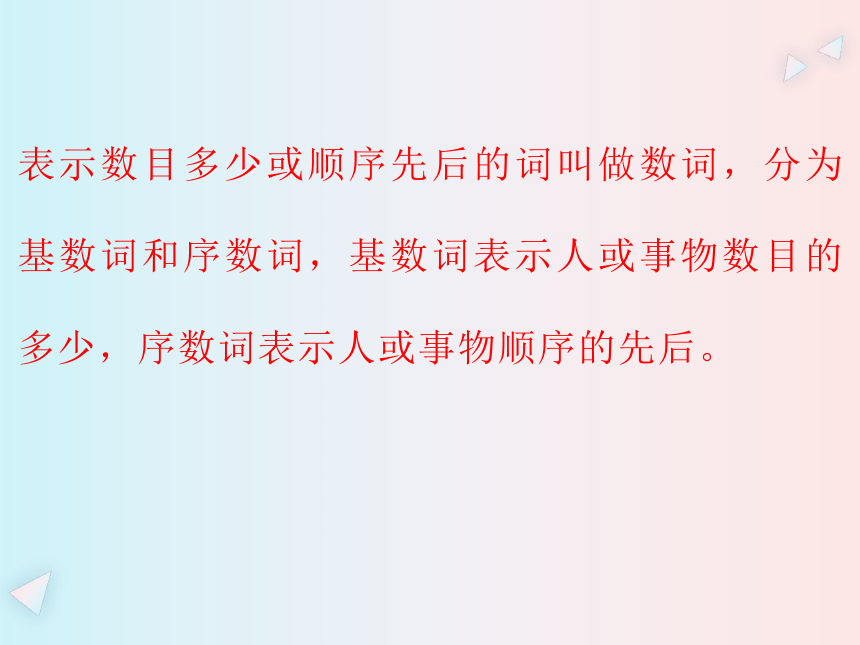
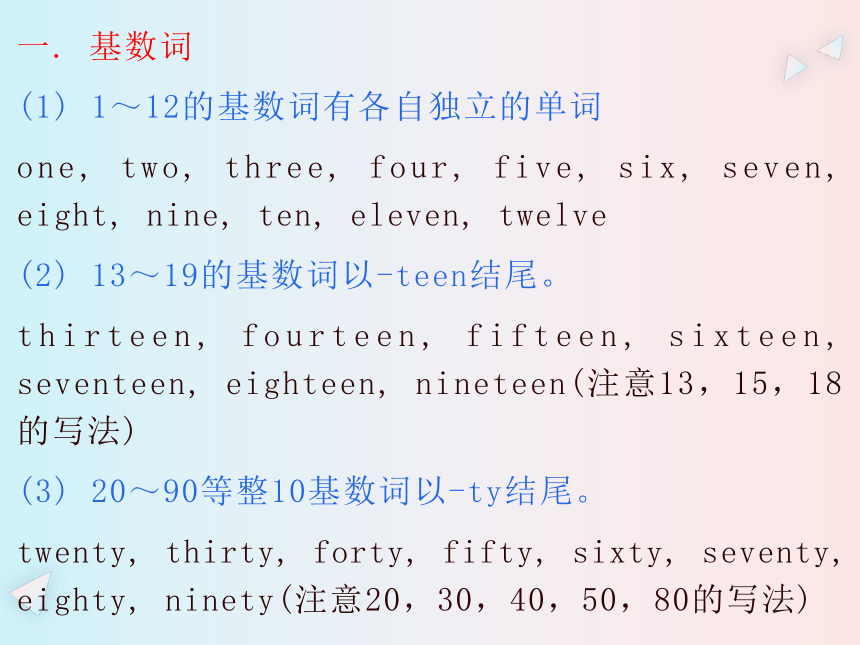
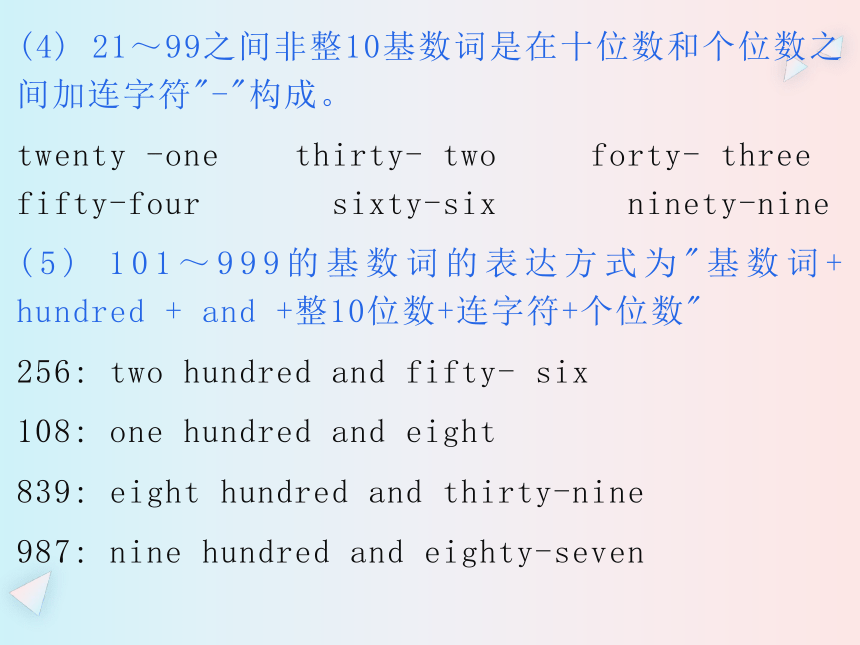
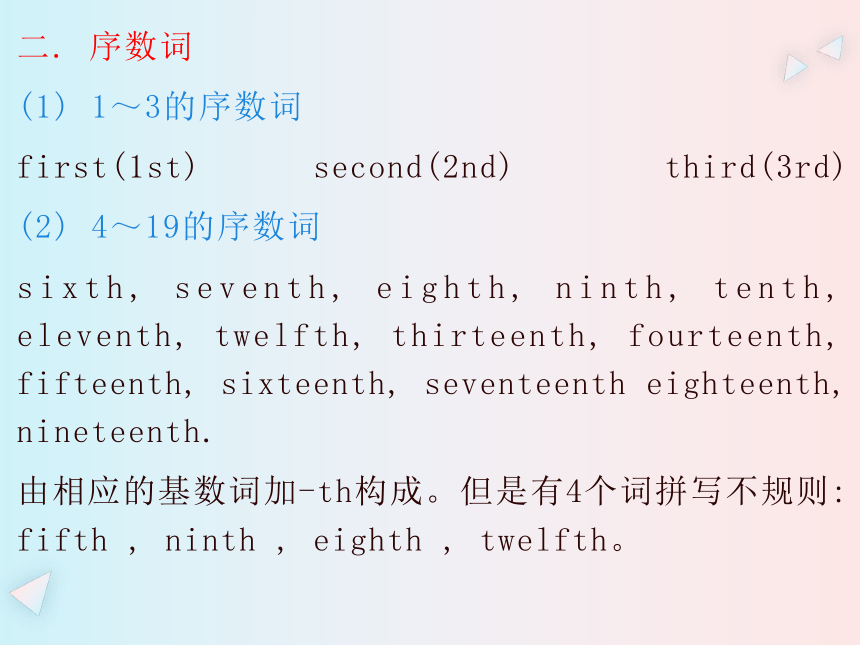
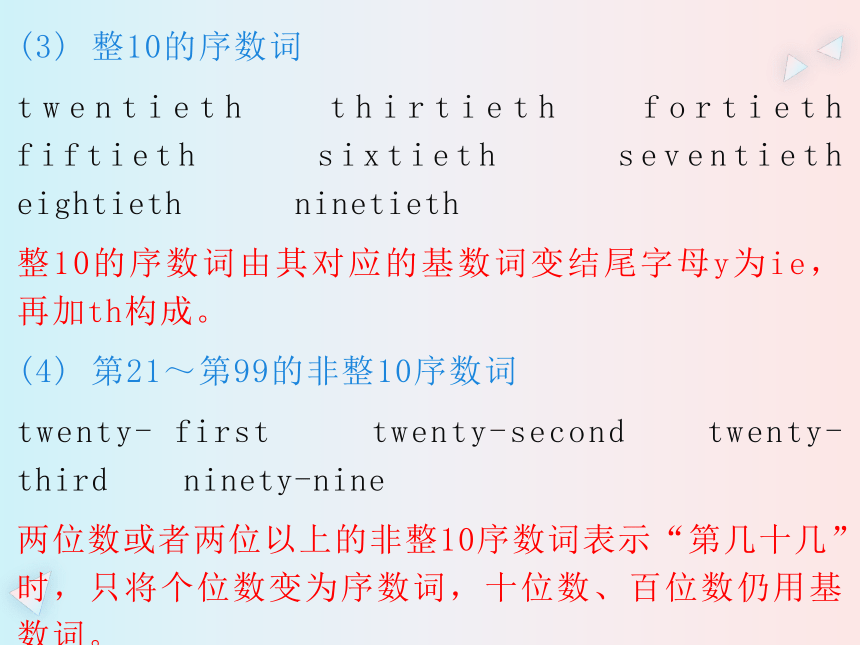
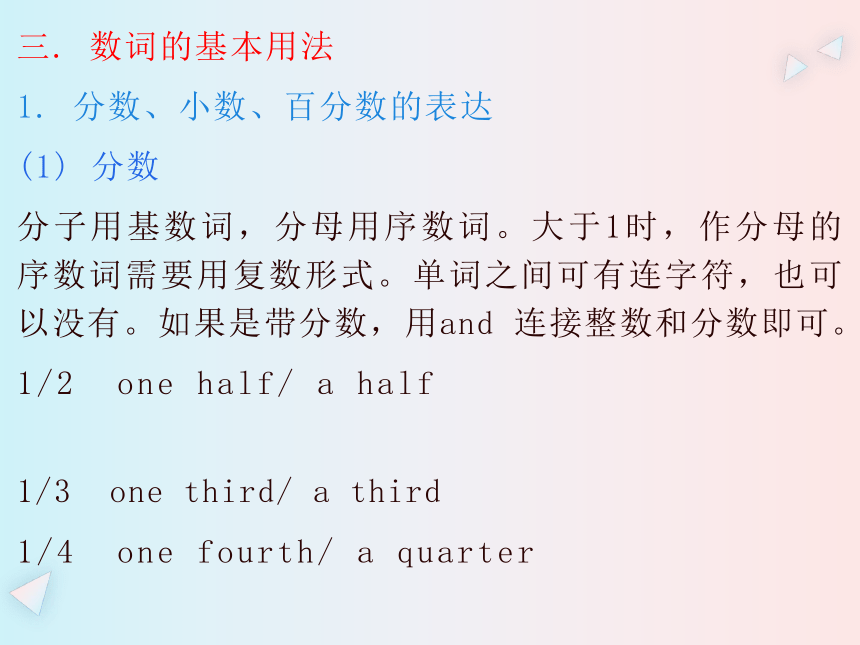
文档简介
(共18张PPT)
初中英语语法大全
数词
表示数目多少或顺序先后的词叫做数词,分为基数词和序数词,基数词表示人或事物数目的多少,序数词表示人或事物顺序的先后。
一. 基数词
(1) 1~12的基数词有各自独立的单词
one, two, three, four, five, six, seven, eight, nine, ten, eleven, twelve
(2) 13~19的基数词以-teen结尾。
thirteen, fourteen, fifteen, sixteen, seventeen, eighteen, nineteen(注意13,15,18的写法)
(3) 20~90等整10基数词以-ty结尾。
twenty, thirty, forty, fifty, sixty, seventy, eighty, ninety(注意20,30,40,50,80的写法)
(4) 21~99之间非整10基数词是在十位数和个位数之间加连字符"-"构成。
twenty -one thirty- two forty- three fifty-four sixty-six ninety-nine
(5) 101~999的基数词的表达方式为"基数词+ hundred + and +整10位数+连字符+个位数"
256: two hundred and fifty- six
108: one hundred and eight
839: eight hundred and thirty-nine
987: nine hundred and eighty-seven
二. 序数词
(1) 1~3的序数词
first(1st) second(2nd) third(3rd)
(2) 4~19的序数词
sixth, seventh, eighth, ninth, tenth, eleventh, twelfth, thirteenth, fourteenth, fifteenth, sixteenth, seventeenth eighteenth, nineteenth.
由相应的基数词加-th构成。但是有4个词拼写不规则: fifth , ninth , eighth , twelfth。
(3) 整10的序数词
twentieth thirtieth fortieth fiftieth sixtieth seventieth eightieth ninetieth
整10的序数词由其对应的基数词变结尾字母y为ie,再加th构成。
(4) 第21~第99的非整10序数词
twenty- first twenty-second twenty- third ninety-nine
两位数或者两位以上的非整10序数词表示“第几十几”时,只将个位数变为序数词,十位数、百位数仍用基数词。
三. 数词的基本用法
1. 分数、小数、百分数的表达
(1) 分数
分子用基数词,分母用序数词。大于1时,作分母的序数词需要用复数形式。单词之间可有连字符,也可以没有。如果是带分数,用and 连接整数和分数即可。
1/2 one half/ a half
1/3 one third/ a third
1/4 one fourth/ a quarter
2/3 two thirds
(2) 小数
小数点读作point,小数点前的数与基数词的读法一样,小数点后的数字一一读出。
0.05 zero point zero five
0.36 zero point three six
28.36 two eight point two three 或 twenty -eight point two three
(3) 百分数
百分数用基数词加百分号,表示百分号读作percent。
50% fifty percent
35% thirty-five percent
It's very important that I study for it because it makes up certain percent of the final exam.
Who fought in percent of the water has been polluted.
2. 表示日期
(1) 年份的表示法和读法
年份通常用阿拉伯数字表示,用基数词读公元前用BC表示,公元用AD表示。AD一般用于公元1到公元999之间的年份。
It contented 54,951 coins dating from the years 260-275AD.
The CCTV has been broadcasting English programmes ever since 1977.
(2) 月、日的表示
表示月、日既可以先写月再写日,也可先写日再写月,日期中的几号可用基数词,也可用序数词,但要注意读法。
6月1日: June 1或者1 June
读作: June the first 或者 the first of June
12月25日: December 25(th) 或者 25(th) December
读作: December ( the ) twenty-fifth 或者 the twenty-fifth of December
(3) 年份的表示法和读法
年代用年份的阿拉伯数字加“-'s”或者"-s"表示。表达“......年代”时用逢10的基数词的复数形式表示,初期、中期、末期分别用early ,mid-和late表示。
在18世纪20年代: in the 1720s/ 1720's
在20世纪90年代中期: in the mid-1990s/ mid-1990's
3. 表示年龄
(1) 一般情况下多用单词表示年龄,也可以用数字进行强调。
She is a student, 16, from the United States.
I am 18 years old, when I start to live on my own.
(2) “在......岁”的表示法
表示一个人具体的岁数时,可以用“at the age of +基数词”或者“at age +基数词”或者“at+基数词”表示。
Li Yundi started to learn the piano at the age of seven.
He set up his own company at 30.
4. 表示编号
编号可用序数词或者基数词表示,序数词位于名词之前,并加定冠词;基数词位于名词之后,名词首字母大写,若基数词为单词,也需要大写首字母,一般情况下,用基数词较为常见。
401房间: Room 401或 the No. 401Room
第五页: Page 5 或 the fifth page
第二课: Lesson Two 或 the second lesson
四、数词的特殊用法
1. 表示确切的数目
表示确切的数目时,用确切数目加hundred, thousand, million等的单数表示。
The volunteers sent two hundred books to a mountain village school on children's day.
-- Guang'an is a beautiful city, isn't it
-- Yes, there are about two thousand visitors here every week.
2. 表示不确切的数目
表示不确切的数目,用hundred, thousand, million等复数形式加of表示。其前还可以被many, several, few等词修饰。
It is reported that people throw hundreds of plastic bags along this street every day.
Did you know that the Earth is home to millions of animals
3. 数量的表示
(1) 表示约数
表示约数时,可用“基数词+名词+or+基数词”。
两三天: two days or three 一两年: one year or two
He will spend two months or three on the work.
(2) 表示“再要几个”
表示“再要几个”时,用“another +数字+复数可数名词”或“数字+ more / other +复数可数名词”结构。
Can you give me another two bags
I think we need five more students.
(3) 复合形容词作定语
由数字和其他名词构成的复合形容词作定语时,其中的名词用单数形式,并且短语中各部分要用连字符来连接。
He's an eight-year-old boy.
Usually children have an eight-week holiday in summer.
Each of us has to write a two-hundred-word report every two weeks.
初中英语语法大全
数词
表示数目多少或顺序先后的词叫做数词,分为基数词和序数词,基数词表示人或事物数目的多少,序数词表示人或事物顺序的先后。
一. 基数词
(1) 1~12的基数词有各自独立的单词
one, two, three, four, five, six, seven, eight, nine, ten, eleven, twelve
(2) 13~19的基数词以-teen结尾。
thirteen, fourteen, fifteen, sixteen, seventeen, eighteen, nineteen(注意13,15,18的写法)
(3) 20~90等整10基数词以-ty结尾。
twenty, thirty, forty, fifty, sixty, seventy, eighty, ninety(注意20,30,40,50,80的写法)
(4) 21~99之间非整10基数词是在十位数和个位数之间加连字符"-"构成。
twenty -one thirty- two forty- three fifty-four sixty-six ninety-nine
(5) 101~999的基数词的表达方式为"基数词+ hundred + and +整10位数+连字符+个位数"
256: two hundred and fifty- six
108: one hundred and eight
839: eight hundred and thirty-nine
987: nine hundred and eighty-seven
二. 序数词
(1) 1~3的序数词
first(1st) second(2nd) third(3rd)
(2) 4~19的序数词
sixth, seventh, eighth, ninth, tenth, eleventh, twelfth, thirteenth, fourteenth, fifteenth, sixteenth, seventeenth eighteenth, nineteenth.
由相应的基数词加-th构成。但是有4个词拼写不规则: fifth , ninth , eighth , twelfth。
(3) 整10的序数词
twentieth thirtieth fortieth fiftieth sixtieth seventieth eightieth ninetieth
整10的序数词由其对应的基数词变结尾字母y为ie,再加th构成。
(4) 第21~第99的非整10序数词
twenty- first twenty-second twenty- third ninety-nine
两位数或者两位以上的非整10序数词表示“第几十几”时,只将个位数变为序数词,十位数、百位数仍用基数词。
三. 数词的基本用法
1. 分数、小数、百分数的表达
(1) 分数
分子用基数词,分母用序数词。大于1时,作分母的序数词需要用复数形式。单词之间可有连字符,也可以没有。如果是带分数,用and 连接整数和分数即可。
1/2 one half/ a half
1/3 one third/ a third
1/4 one fourth/ a quarter
2/3 two thirds
(2) 小数
小数点读作point,小数点前的数与基数词的读法一样,小数点后的数字一一读出。
0.05 zero point zero five
0.36 zero point three six
28.36 two eight point two three 或 twenty -eight point two three
(3) 百分数
百分数用基数词加百分号,表示百分号读作percent。
50% fifty percent
35% thirty-five percent
It's very important that I study for it because it makes up certain percent of the final exam.
Who fought in percent of the water has been polluted.
2. 表示日期
(1) 年份的表示法和读法
年份通常用阿拉伯数字表示,用基数词读公元前用BC表示,公元用AD表示。AD一般用于公元1到公元999之间的年份。
It contented 54,951 coins dating from the years 260-275AD.
The CCTV has been broadcasting English programmes ever since 1977.
(2) 月、日的表示
表示月、日既可以先写月再写日,也可先写日再写月,日期中的几号可用基数词,也可用序数词,但要注意读法。
6月1日: June 1或者1 June
读作: June the first 或者 the first of June
12月25日: December 25(th) 或者 25(th) December
读作: December ( the ) twenty-fifth 或者 the twenty-fifth of December
(3) 年份的表示法和读法
年代用年份的阿拉伯数字加“-'s”或者"-s"表示。表达“......年代”时用逢10的基数词的复数形式表示,初期、中期、末期分别用early ,mid-和late表示。
在18世纪20年代: in the 1720s/ 1720's
在20世纪90年代中期: in the mid-1990s/ mid-1990's
3. 表示年龄
(1) 一般情况下多用单词表示年龄,也可以用数字进行强调。
She is a student, 16, from the United States.
I am 18 years old, when I start to live on my own.
(2) “在......岁”的表示法
表示一个人具体的岁数时,可以用“at the age of +基数词”或者“at age +基数词”或者“at+基数词”表示。
Li Yundi started to learn the piano at the age of seven.
He set up his own company at 30.
4. 表示编号
编号可用序数词或者基数词表示,序数词位于名词之前,并加定冠词;基数词位于名词之后,名词首字母大写,若基数词为单词,也需要大写首字母,一般情况下,用基数词较为常见。
401房间: Room 401或 the No. 401Room
第五页: Page 5 或 the fifth page
第二课: Lesson Two 或 the second lesson
四、数词的特殊用法
1. 表示确切的数目
表示确切的数目时,用确切数目加hundred, thousand, million等的单数表示。
The volunteers sent two hundred books to a mountain village school on children's day.
-- Guang'an is a beautiful city, isn't it
-- Yes, there are about two thousand visitors here every week.
2. 表示不确切的数目
表示不确切的数目,用hundred, thousand, million等复数形式加of表示。其前还可以被many, several, few等词修饰。
It is reported that people throw hundreds of plastic bags along this street every day.
Did you know that the Earth is home to millions of animals
3. 数量的表示
(1) 表示约数
表示约数时,可用“基数词+名词+or+基数词”。
两三天: two days or three 一两年: one year or two
He will spend two months or three on the work.
(2) 表示“再要几个”
表示“再要几个”时,用“another +数字+复数可数名词”或“数字+ more / other +复数可数名词”结构。
Can you give me another two bags
I think we need five more students.
(3) 复合形容词作定语
由数字和其他名词构成的复合形容词作定语时,其中的名词用单数形式,并且短语中各部分要用连字符来连接。
He's an eight-year-old boy.
Usually children have an eight-week holiday in summer.
Each of us has to write a two-hundred-word report every two weeks.
同课章节目录
- 词法
- 名词
- 动词和动词短语
- 动词语态
- 动词时态
- 助动词和情态动词
- 非谓语动词
- 冠词
- 代词
- 数词和量词
- 形容词副词及其比较等级
- 介词和介词短语
- 连词和感叹词
- 构词法
- 相似、相近词比较
- 句法
- 陈述句
- 一般疑问句和否定疑问句
- 特殊疑问句及选择疑问句
- 反意疑问句
- 存在句(There be句型)
- 宾语从句
- 定语从句
- 状语从句
- 主谓一致问题
- 简单句
- 并列句
- 复合句
- 主谓一致
- 主、表语从句
- 名词性从句
- 直接引语和间接引语
- 虚拟语气
- 感叹句
- 强调句
- 倒装句
- 祈使句
- 句子的成分
- 句子的分类
- 题型专区
- 单项选择部分
- 易错题
- 完形填空
- 阅读理解
- 词汇练习
- 听说训练
- 句型转换
- 补全对话
- 短文改错
- 翻译
- 书面表达
- 任务型阅读
- 语法填空
- 其他资料
